The Correlation Between Procrastination and Personality Among Students
VerifiedAdded on 2022/10/19
|18
|2864
|18
Report
AI Summary
This report presents a study investigating the correlation between procrastination and personality traits among students. The research explores the relationship between the Big Five personality traits (Conscientiousness, Neuroticism, Openness, Extraversion, and Agreeableness) and varying levels of procrastination (low, average, and high) in both professional and non-professional students. The study involved a sample of 134 students, using the Procrastination Scale and NEO Five-Factor Inventory (NEO-FFI). The researchers aimed to determine if there was a significant connection between personality traits and procrastination levels, considering differences between genders. The results indicated no significant relationship between Extraversion, Openness, Agreeableness, and Neuroticism and the different categories of procrastination, however, the study found that most students are ambient, show signs of anxiety, tension, fear and uncertainty under stress, are interested in innovation and creativity, and not showing any positive behaviors like being kind and welcoming towards other. The study concludes that the sample group can be categorized as average procrastinators.
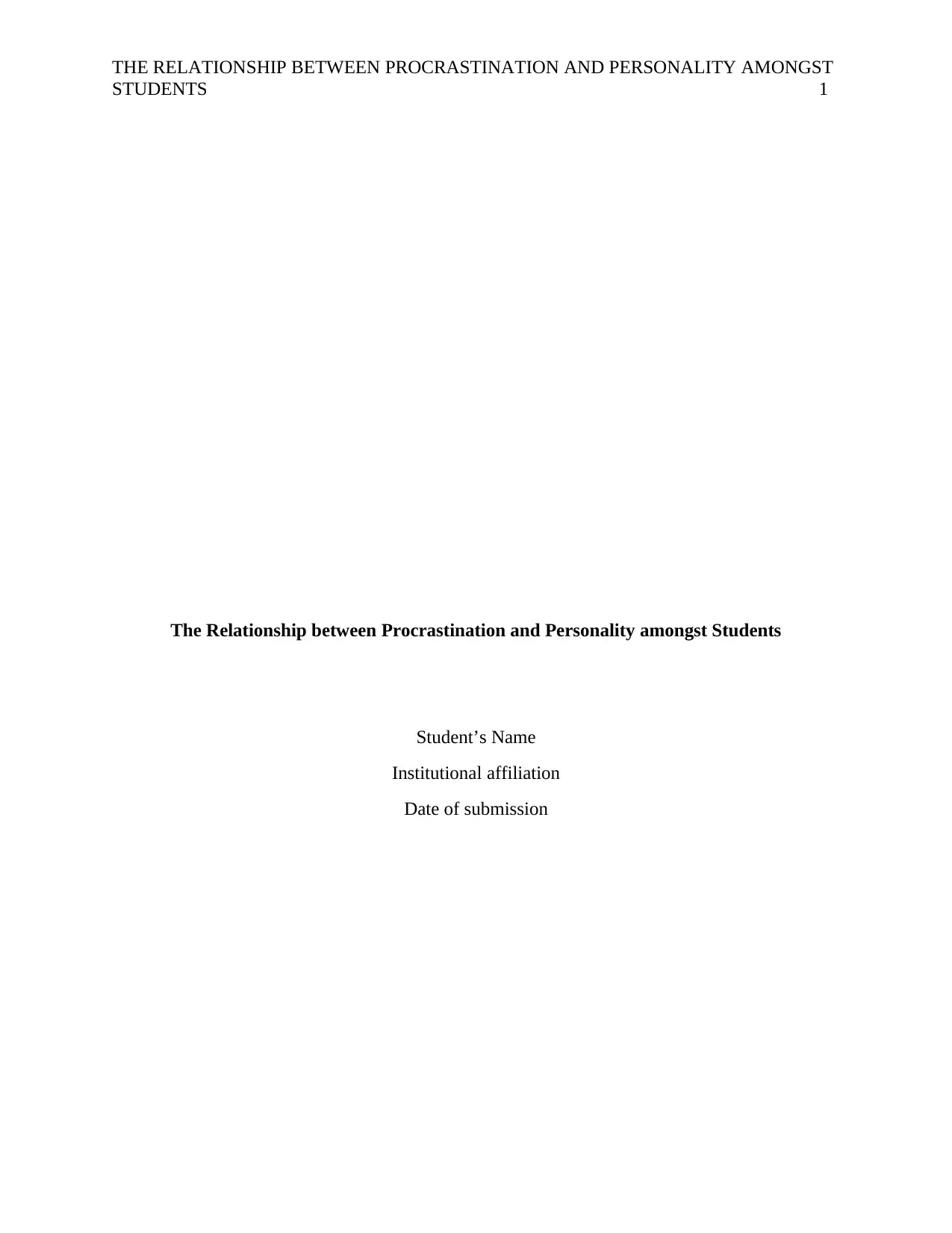
THE RELATIONSHIP BETWEEN PROCRASTINATION AND PERSONALITY AMONGST
STUDENTS 1
The Relationship between Procrastination and Personality amongst Students
Student’s Name
Institutional affiliation
Date of submission
STUDENTS 1
The Relationship between Procrastination and Personality amongst Students
Student’s Name
Institutional affiliation
Date of submission
Paraphrase This Document
Need a fresh take? Get an instant paraphrase of this document with our AI Paraphraser
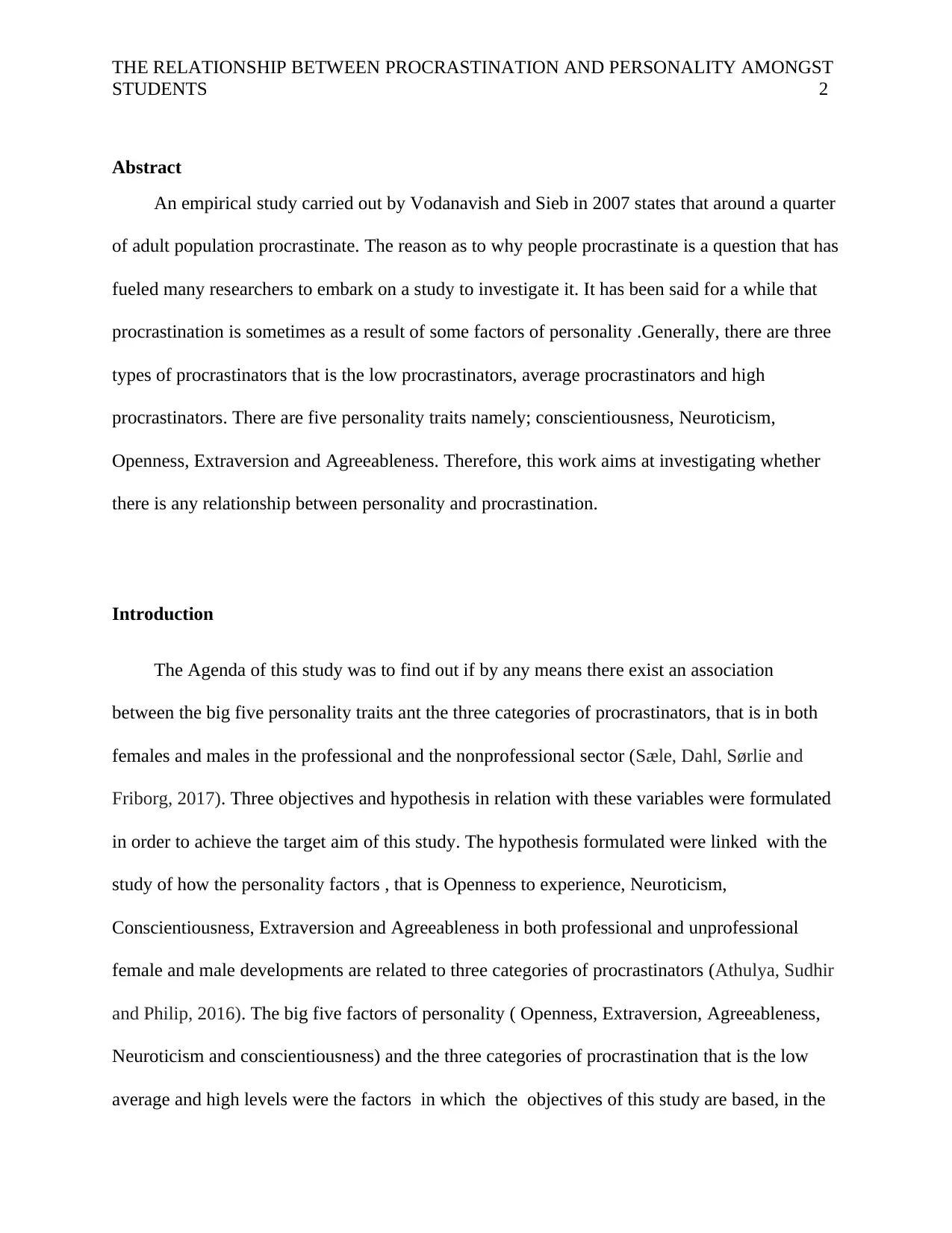
THE RELATIONSHIP BETWEEN PROCRASTINATION AND PERSONALITY AMONGST
STUDENTS 2
Abstract
An empirical study carried out by Vodanavish and Sieb in 2007 states that around a quarter
of adult population procrastinate. The reason as to why people procrastinate is a question that has
fueled many researchers to embark on a study to investigate it. It has been said for a while that
procrastination is sometimes as a result of some factors of personality .Generally, there are three
types of procrastinators that is the low procrastinators, average procrastinators and high
procrastinators. There are five personality traits namely; conscientiousness, Neuroticism,
Openness, Extraversion and Agreeableness. Therefore, this work aims at investigating whether
there is any relationship between personality and procrastination.
Introduction
The Agenda of this study was to find out if by any means there exist an association
between the big five personality traits ant the three categories of procrastinators, that is in both
females and males in the professional and the nonprofessional sector (Sæle, Dahl, Sørlie and
Friborg, 2017). Three objectives and hypothesis in relation with these variables were formulated
in order to achieve the target aim of this study. The hypothesis formulated were linked with the
study of how the personality factors , that is Openness to experience, Neuroticism,
Conscientiousness, Extraversion and Agreeableness in both professional and unprofessional
female and male developments are related to three categories of procrastinators (Athulya, Sudhir
and Philip, 2016). The big five factors of personality ( Openness, Extraversion, Agreeableness,
Neuroticism and conscientiousness) and the three categories of procrastination that is the low
average and high levels were the factors in which the objectives of this study are based, in the
STUDENTS 2
Abstract
An empirical study carried out by Vodanavish and Sieb in 2007 states that around a quarter
of adult population procrastinate. The reason as to why people procrastinate is a question that has
fueled many researchers to embark on a study to investigate it. It has been said for a while that
procrastination is sometimes as a result of some factors of personality .Generally, there are three
types of procrastinators that is the low procrastinators, average procrastinators and high
procrastinators. There are five personality traits namely; conscientiousness, Neuroticism,
Openness, Extraversion and Agreeableness. Therefore, this work aims at investigating whether
there is any relationship between personality and procrastination.
Introduction
The Agenda of this study was to find out if by any means there exist an association
between the big five personality traits ant the three categories of procrastinators, that is in both
females and males in the professional and the nonprofessional sector (Sæle, Dahl, Sørlie and
Friborg, 2017). Three objectives and hypothesis in relation with these variables were formulated
in order to achieve the target aim of this study. The hypothesis formulated were linked with the
study of how the personality factors , that is Openness to experience, Neuroticism,
Conscientiousness, Extraversion and Agreeableness in both professional and unprofessional
female and male developments are related to three categories of procrastinators (Athulya, Sudhir
and Philip, 2016). The big five factors of personality ( Openness, Extraversion, Agreeableness,
Neuroticism and conscientiousness) and the three categories of procrastination that is the low
average and high levels were the factors in which the objectives of this study are based, in the
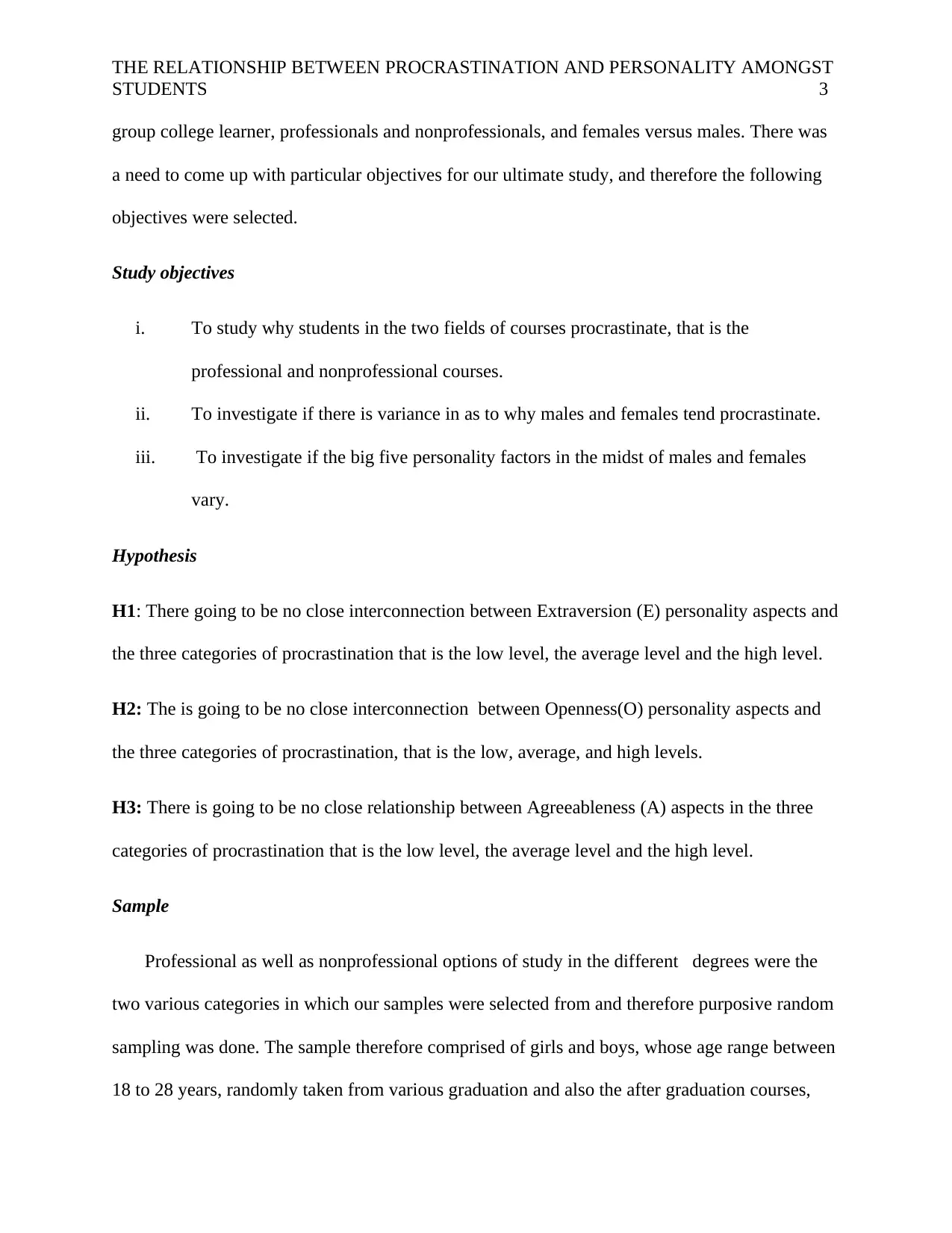
THE RELATIONSHIP BETWEEN PROCRASTINATION AND PERSONALITY AMONGST
STUDENTS 3
group college learner, professionals and nonprofessionals, and females versus males. There was
a need to come up with particular objectives for our ultimate study, and therefore the following
objectives were selected.
Study objectives
i. To study why students in the two fields of courses procrastinate, that is the
professional and nonprofessional courses.
ii. To investigate if there is variance in as to why males and females tend procrastinate.
iii. To investigate if the big five personality factors in the midst of males and females
vary.
Hypothesis
H1: There going to be no close interconnection between Extraversion (E) personality aspects and
the three categories of procrastination that is the low level, the average level and the high level.
H2: The is going to be no close interconnection between Openness(O) personality aspects and
the three categories of procrastination, that is the low, average, and high levels.
H3: There is going to be no close relationship between Agreeableness (A) aspects in the three
categories of procrastination that is the low level, the average level and the high level.
Sample
Professional as well as nonprofessional options of study in the different degrees were the
two various categories in which our samples were selected from and therefore purposive random
sampling was done. The sample therefore comprised of girls and boys, whose age range between
18 to 28 years, randomly taken from various graduation and also the after graduation courses,
STUDENTS 3
group college learner, professionals and nonprofessionals, and females versus males. There was
a need to come up with particular objectives for our ultimate study, and therefore the following
objectives were selected.
Study objectives
i. To study why students in the two fields of courses procrastinate, that is the
professional and nonprofessional courses.
ii. To investigate if there is variance in as to why males and females tend procrastinate.
iii. To investigate if the big five personality factors in the midst of males and females
vary.
Hypothesis
H1: There going to be no close interconnection between Extraversion (E) personality aspects and
the three categories of procrastination that is the low level, the average level and the high level.
H2: The is going to be no close interconnection between Openness(O) personality aspects and
the three categories of procrastination, that is the low, average, and high levels.
H3: There is going to be no close relationship between Agreeableness (A) aspects in the three
categories of procrastination that is the low level, the average level and the high level.
Sample
Professional as well as nonprofessional options of study in the different degrees were the
two various categories in which our samples were selected from and therefore purposive random
sampling was done. The sample therefore comprised of girls and boys, whose age range between
18 to 28 years, randomly taken from various graduation and also the after graduation courses,
⊘ This is a preview!⊘
Do you want full access?
Subscribe today to unlock all pages.

Trusted by 1+ million students worldwide
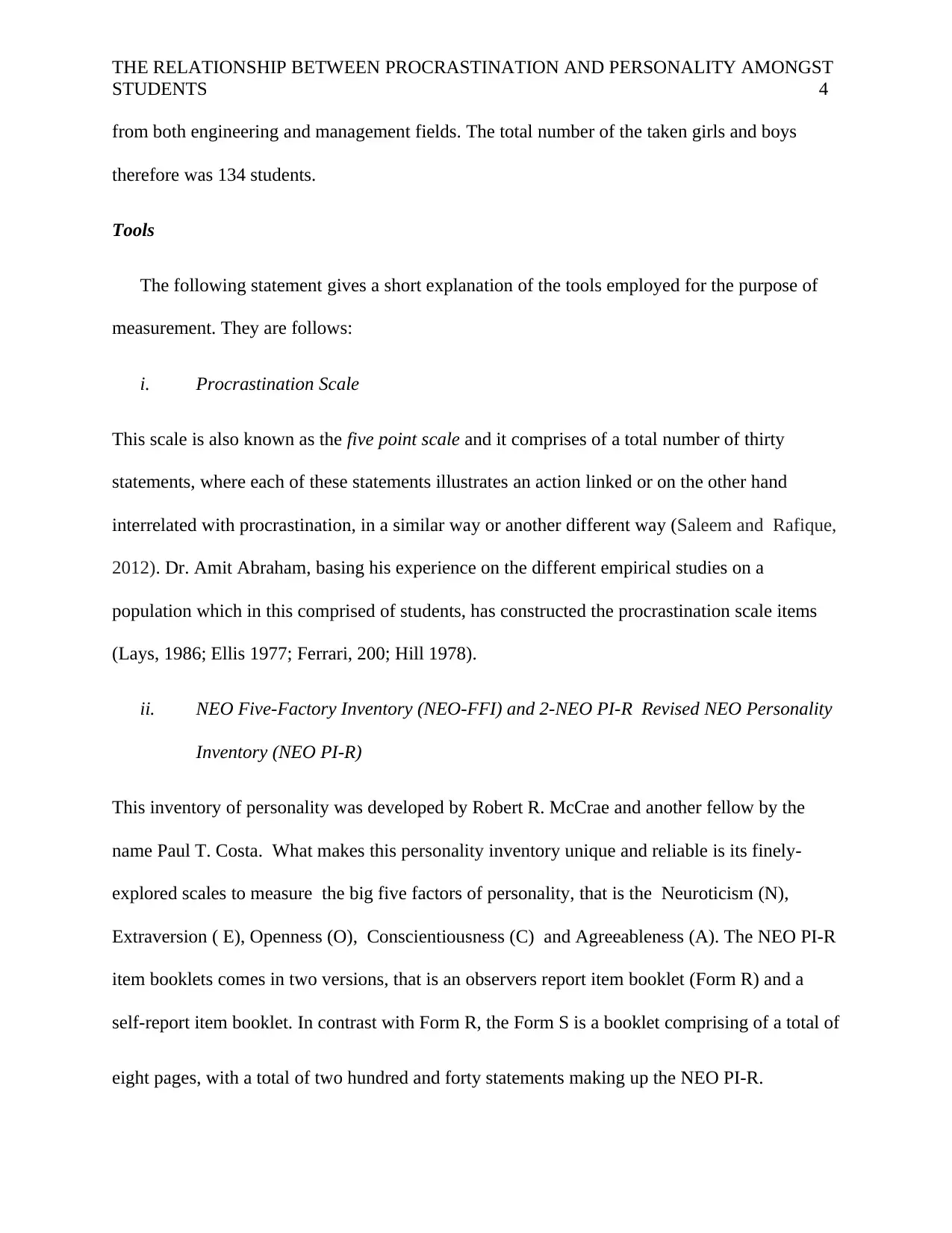
THE RELATIONSHIP BETWEEN PROCRASTINATION AND PERSONALITY AMONGST
STUDENTS 4
from both engineering and management fields. The total number of the taken girls and boys
therefore was 134 students.
Tools
The following statement gives a short explanation of the tools employed for the purpose of
measurement. They are follows:
i. Procrastination Scale
This scale is also known as the five point scale and it comprises of a total number of thirty
statements, where each of these statements illustrates an action linked or on the other hand
interrelated with procrastination, in a similar way or another different way (Saleem and Rafique,
2012). Dr. Amit Abraham, basing his experience on the different empirical studies on a
population which in this comprised of students, has constructed the procrastination scale items
(Lays, 1986; Ellis 1977; Ferrari, 200; Hill 1978).
ii. NEO Five-Factory Inventory (NEO-FFI) and 2-NEO PI-R Revised NEO Personality
Inventory (NEO PI-R)
This inventory of personality was developed by Robert R. McCrae and another fellow by the
name Paul T. Costa. What makes this personality inventory unique and reliable is its finely-
explored scales to measure the big five factors of personality, that is the Neuroticism (N),
Extraversion ( E), Openness (O), Conscientiousness (C) and Agreeableness (A). The NEO PI-R
item booklets comes in two versions, that is an observers report item booklet (Form R) and a
self-report item booklet. In contrast with Form R, the Form S is a booklet comprising of a total of
eight pages, with a total of two hundred and forty statements making up the NEO PI-R.
STUDENTS 4
from both engineering and management fields. The total number of the taken girls and boys
therefore was 134 students.
Tools
The following statement gives a short explanation of the tools employed for the purpose of
measurement. They are follows:
i. Procrastination Scale
This scale is also known as the five point scale and it comprises of a total number of thirty
statements, where each of these statements illustrates an action linked or on the other hand
interrelated with procrastination, in a similar way or another different way (Saleem and Rafique,
2012). Dr. Amit Abraham, basing his experience on the different empirical studies on a
population which in this comprised of students, has constructed the procrastination scale items
(Lays, 1986; Ellis 1977; Ferrari, 200; Hill 1978).
ii. NEO Five-Factory Inventory (NEO-FFI) and 2-NEO PI-R Revised NEO Personality
Inventory (NEO PI-R)
This inventory of personality was developed by Robert R. McCrae and another fellow by the
name Paul T. Costa. What makes this personality inventory unique and reliable is its finely-
explored scales to measure the big five factors of personality, that is the Neuroticism (N),
Extraversion ( E), Openness (O), Conscientiousness (C) and Agreeableness (A). The NEO PI-R
item booklets comes in two versions, that is an observers report item booklet (Form R) and a
self-report item booklet. In contrast with Form R, the Form S is a booklet comprising of a total of
eight pages, with a total of two hundred and forty statements making up the NEO PI-R.
Paraphrase This Document
Need a fresh take? Get an instant paraphrase of this document with our AI Paraphraser
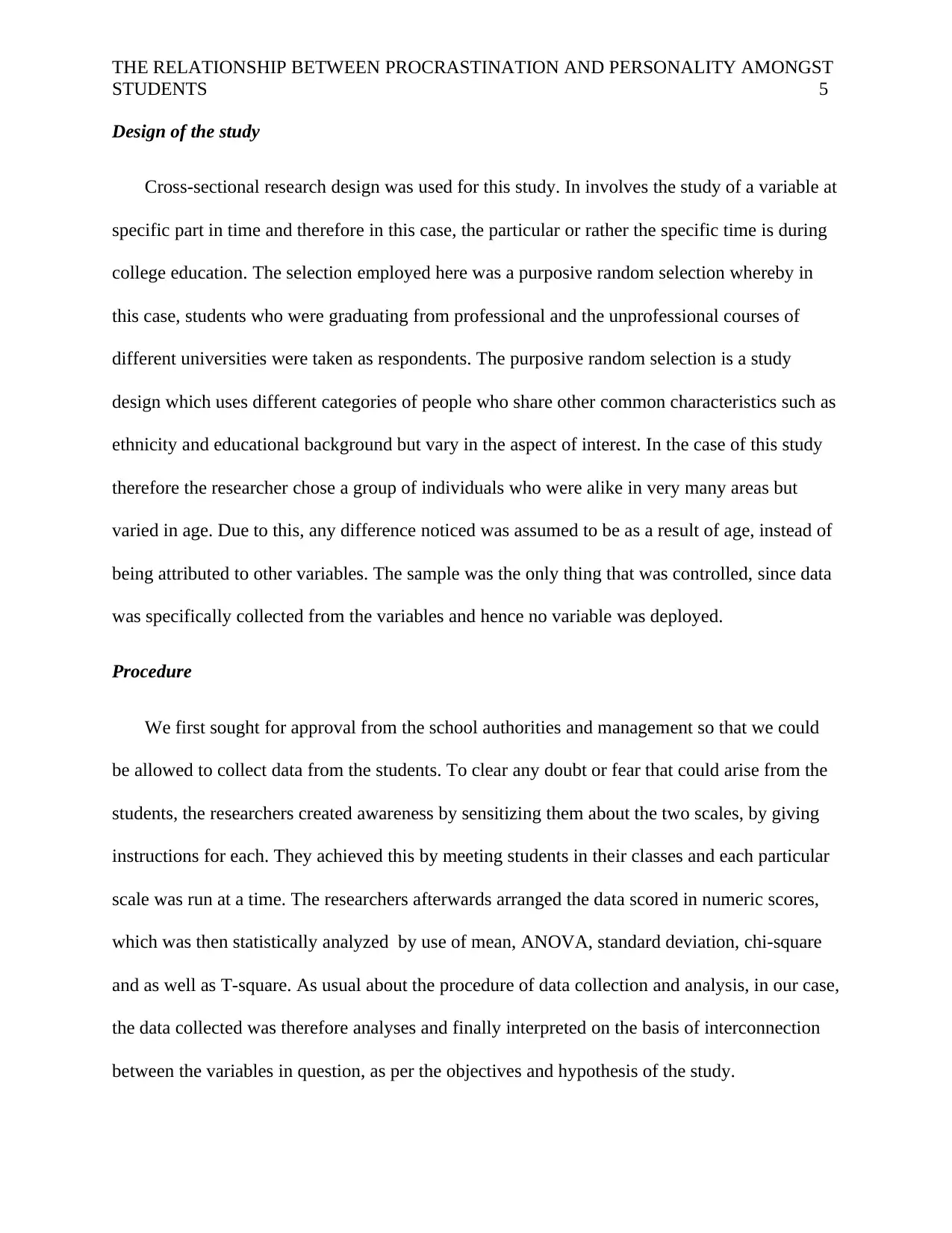
THE RELATIONSHIP BETWEEN PROCRASTINATION AND PERSONALITY AMONGST
STUDENTS 5
Design of the study
Cross-sectional research design was used for this study. In involves the study of a variable at
specific part in time and therefore in this case, the particular or rather the specific time is during
college education. The selection employed here was a purposive random selection whereby in
this case, students who were graduating from professional and the unprofessional courses of
different universities were taken as respondents. The purposive random selection is a study
design which uses different categories of people who share other common characteristics such as
ethnicity and educational background but vary in the aspect of interest. In the case of this study
therefore the researcher chose a group of individuals who were alike in very many areas but
varied in age. Due to this, any difference noticed was assumed to be as a result of age, instead of
being attributed to other variables. The sample was the only thing that was controlled, since data
was specifically collected from the variables and hence no variable was deployed.
Procedure
We first sought for approval from the school authorities and management so that we could
be allowed to collect data from the students. To clear any doubt or fear that could arise from the
students, the researchers created awareness by sensitizing them about the two scales, by giving
instructions for each. They achieved this by meeting students in their classes and each particular
scale was run at a time. The researchers afterwards arranged the data scored in numeric scores,
which was then statistically analyzed by use of mean, ANOVA, standard deviation, chi-square
and as well as T-square. As usual about the procedure of data collection and analysis, in our case,
the data collected was therefore analyses and finally interpreted on the basis of interconnection
between the variables in question, as per the objectives and hypothesis of the study.
STUDENTS 5
Design of the study
Cross-sectional research design was used for this study. In involves the study of a variable at
specific part in time and therefore in this case, the particular or rather the specific time is during
college education. The selection employed here was a purposive random selection whereby in
this case, students who were graduating from professional and the unprofessional courses of
different universities were taken as respondents. The purposive random selection is a study
design which uses different categories of people who share other common characteristics such as
ethnicity and educational background but vary in the aspect of interest. In the case of this study
therefore the researcher chose a group of individuals who were alike in very many areas but
varied in age. Due to this, any difference noticed was assumed to be as a result of age, instead of
being attributed to other variables. The sample was the only thing that was controlled, since data
was specifically collected from the variables and hence no variable was deployed.
Procedure
We first sought for approval from the school authorities and management so that we could
be allowed to collect data from the students. To clear any doubt or fear that could arise from the
students, the researchers created awareness by sensitizing them about the two scales, by giving
instructions for each. They achieved this by meeting students in their classes and each particular
scale was run at a time. The researchers afterwards arranged the data scored in numeric scores,
which was then statistically analyzed by use of mean, ANOVA, standard deviation, chi-square
and as well as T-square. As usual about the procedure of data collection and analysis, in our case,
the data collected was therefore analyses and finally interpreted on the basis of interconnection
between the variables in question, as per the objectives and hypothesis of the study.
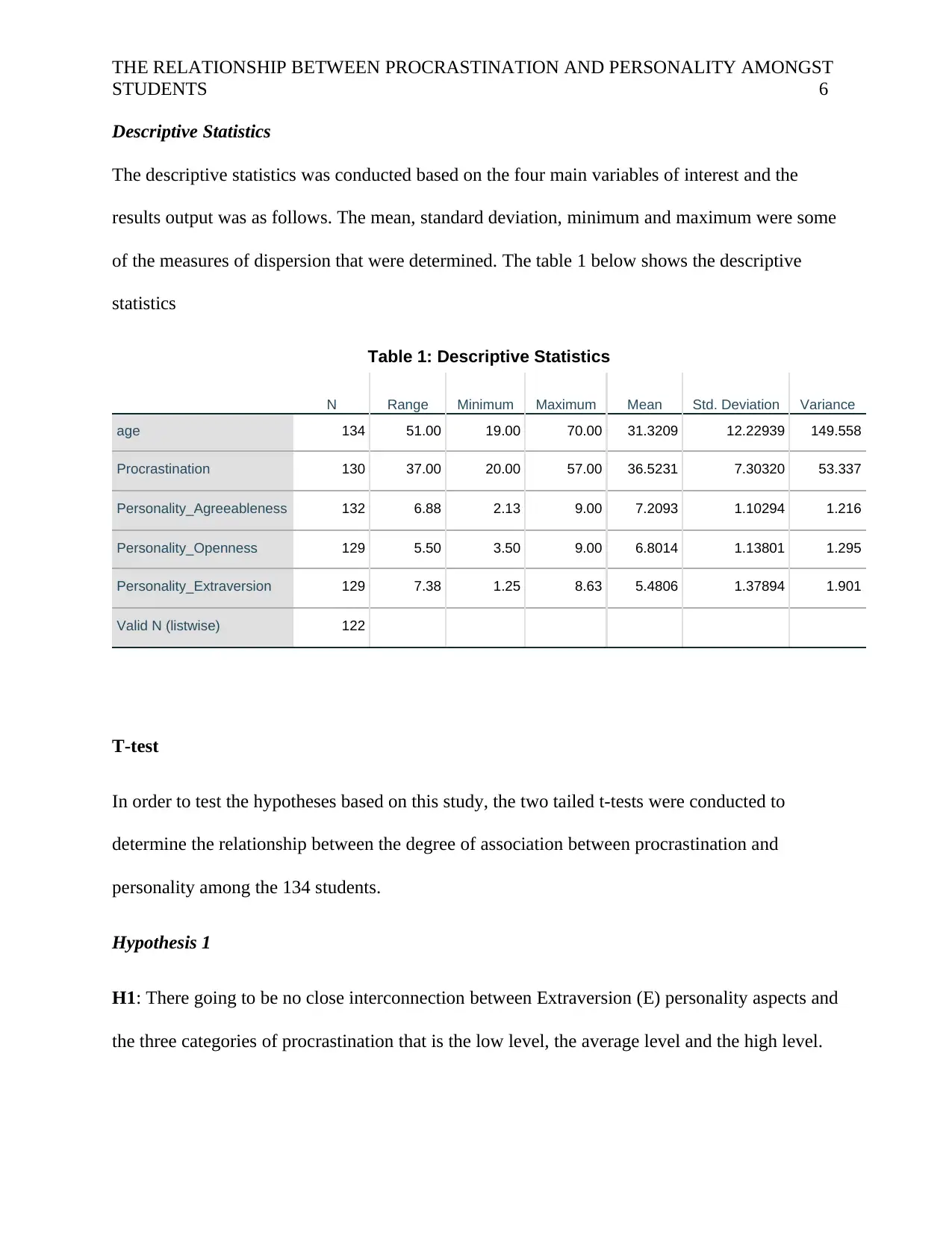
THE RELATIONSHIP BETWEEN PROCRASTINATION AND PERSONALITY AMONGST
STUDENTS 6
Descriptive Statistics
The descriptive statistics was conducted based on the four main variables of interest and the
results output was as follows. The mean, standard deviation, minimum and maximum were some
of the measures of dispersion that were determined. The table 1 below shows the descriptive
statistics
Table 1: Descriptive Statistics
N Range Minimum Maximum Mean Std. Deviation Variance
age 134 51.00 19.00 70.00 31.3209 12.22939 149.558
Procrastination 130 37.00 20.00 57.00 36.5231 7.30320 53.337
Personality_Agreeableness 132 6.88 2.13 9.00 7.2093 1.10294 1.216
Personality_Openness 129 5.50 3.50 9.00 6.8014 1.13801 1.295
Personality_Extraversion 129 7.38 1.25 8.63 5.4806 1.37894 1.901
Valid N (listwise) 122
T-test
In order to test the hypotheses based on this study, the two tailed t-tests were conducted to
determine the relationship between the degree of association between procrastination and
personality among the 134 students.
Hypothesis 1
H1: There going to be no close interconnection between Extraversion (E) personality aspects and
the three categories of procrastination that is the low level, the average level and the high level.
STUDENTS 6
Descriptive Statistics
The descriptive statistics was conducted based on the four main variables of interest and the
results output was as follows. The mean, standard deviation, minimum and maximum were some
of the measures of dispersion that were determined. The table 1 below shows the descriptive
statistics
Table 1: Descriptive Statistics
N Range Minimum Maximum Mean Std. Deviation Variance
age 134 51.00 19.00 70.00 31.3209 12.22939 149.558
Procrastination 130 37.00 20.00 57.00 36.5231 7.30320 53.337
Personality_Agreeableness 132 6.88 2.13 9.00 7.2093 1.10294 1.216
Personality_Openness 129 5.50 3.50 9.00 6.8014 1.13801 1.295
Personality_Extraversion 129 7.38 1.25 8.63 5.4806 1.37894 1.901
Valid N (listwise) 122
T-test
In order to test the hypotheses based on this study, the two tailed t-tests were conducted to
determine the relationship between the degree of association between procrastination and
personality among the 134 students.
Hypothesis 1
H1: There going to be no close interconnection between Extraversion (E) personality aspects and
the three categories of procrastination that is the low level, the average level and the high level.
⊘ This is a preview!⊘
Do you want full access?
Subscribe today to unlock all pages.

Trusted by 1+ million students worldwide
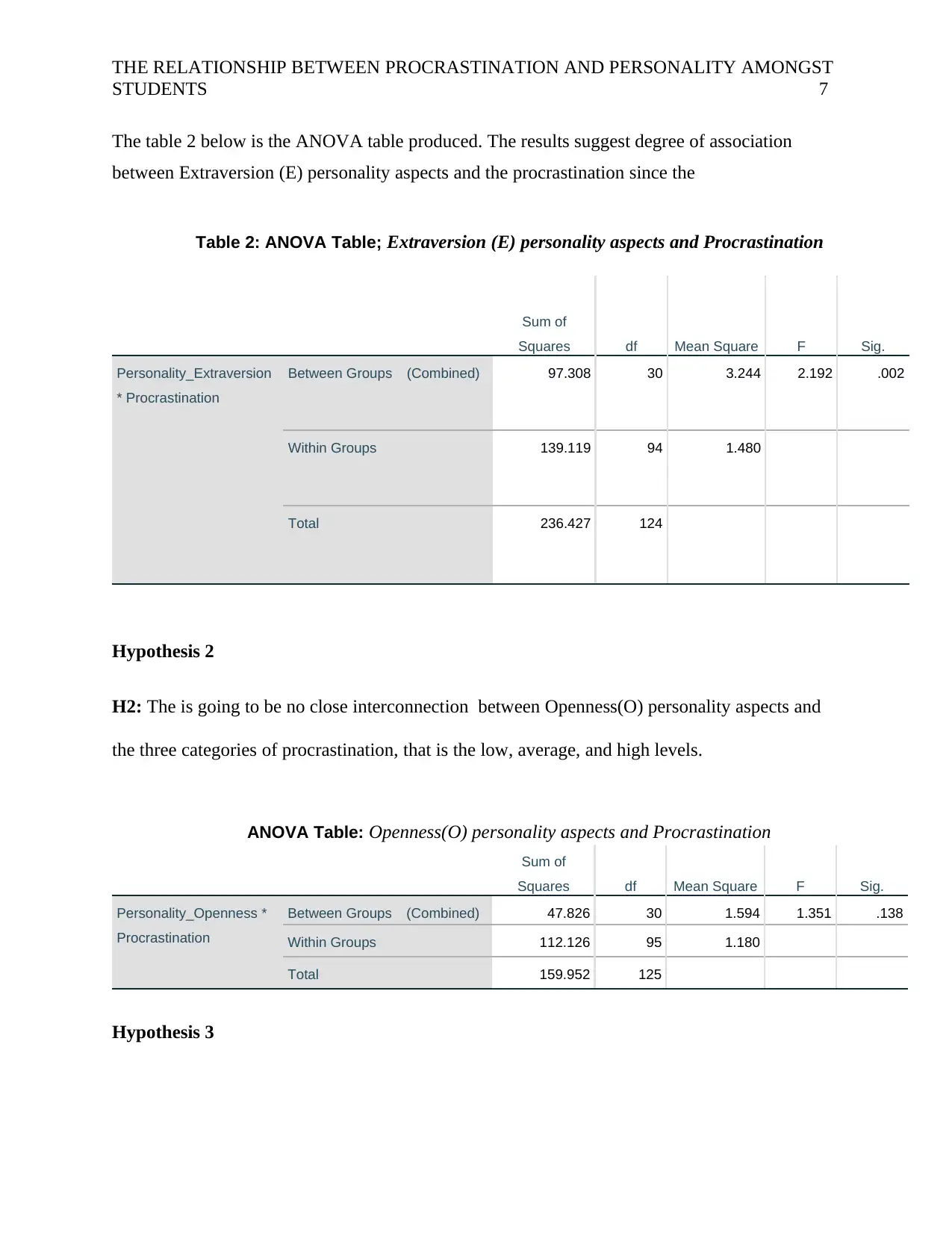
THE RELATIONSHIP BETWEEN PROCRASTINATION AND PERSONALITY AMONGST
STUDENTS 7
The table 2 below is the ANOVA table produced. The results suggest degree of association
between Extraversion (E) personality aspects and the procrastination since the
Table 2: ANOVA Table; Extraversion (E) personality aspects and Procrastination
Sum of
Squares df Mean Square F Sig.
Personality_Extraversion
* Procrastination
Between Groups (Combined) 97.308 30 3.244 2.192 .002
Within Groups 139.119 94 1.480
Total 236.427 124
Hypothesis 2
H2: The is going to be no close interconnection between Openness(O) personality aspects and
the three categories of procrastination, that is the low, average, and high levels.
ANOVA Table: Openness(O) personality aspects and Procrastination
Sum of
Squares df Mean Square F Sig.
Personality_Openness *
Procrastination
Between Groups (Combined) 47.826 30 1.594 1.351 .138
Within Groups 112.126 95 1.180
Total 159.952 125
Hypothesis 3
STUDENTS 7
The table 2 below is the ANOVA table produced. The results suggest degree of association
between Extraversion (E) personality aspects and the procrastination since the
Table 2: ANOVA Table; Extraversion (E) personality aspects and Procrastination
Sum of
Squares df Mean Square F Sig.
Personality_Extraversion
* Procrastination
Between Groups (Combined) 97.308 30 3.244 2.192 .002
Within Groups 139.119 94 1.480
Total 236.427 124
Hypothesis 2
H2: The is going to be no close interconnection between Openness(O) personality aspects and
the three categories of procrastination, that is the low, average, and high levels.
ANOVA Table: Openness(O) personality aspects and Procrastination
Sum of
Squares df Mean Square F Sig.
Personality_Openness *
Procrastination
Between Groups (Combined) 47.826 30 1.594 1.351 .138
Within Groups 112.126 95 1.180
Total 159.952 125
Hypothesis 3
Paraphrase This Document
Need a fresh take? Get an instant paraphrase of this document with our AI Paraphraser
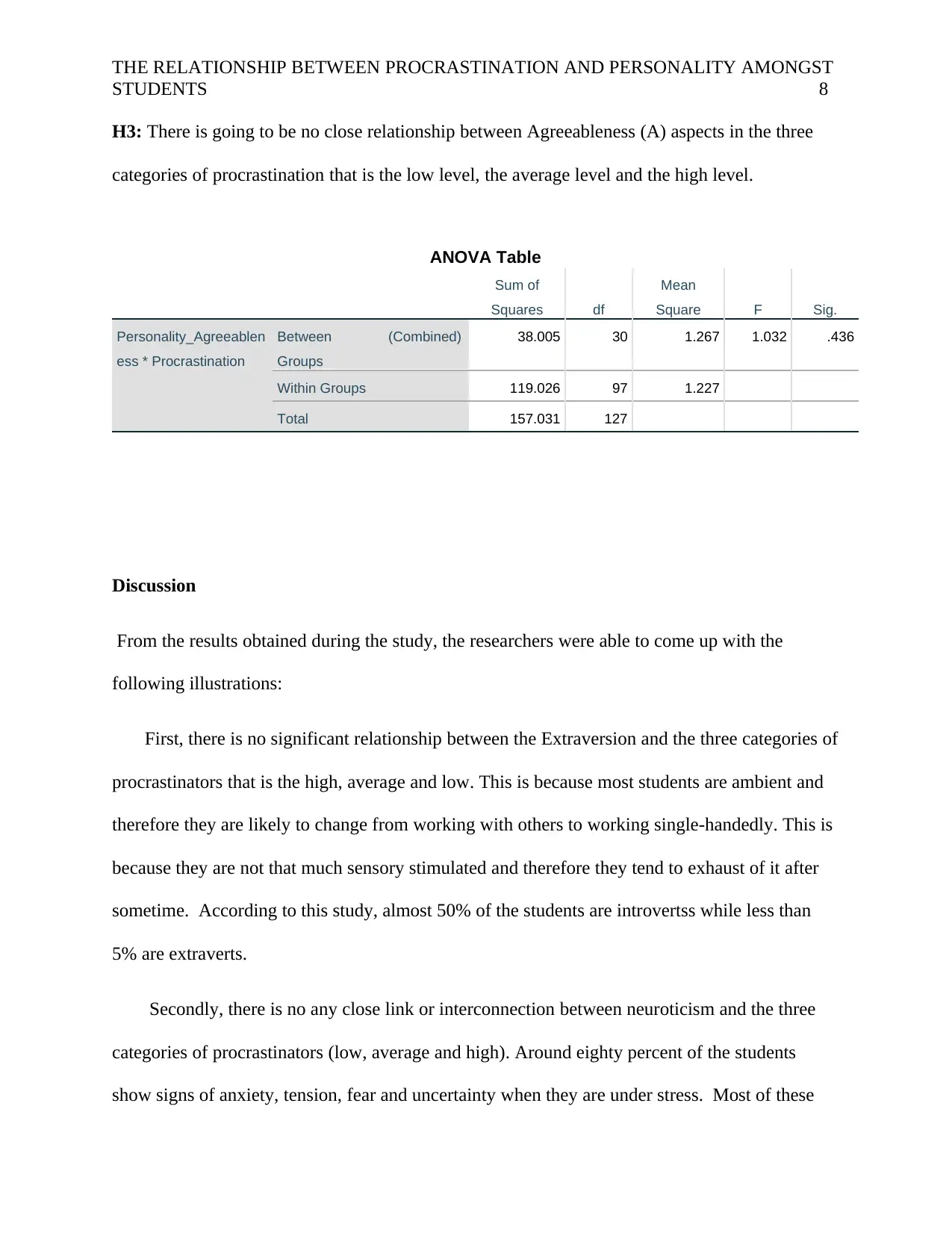
THE RELATIONSHIP BETWEEN PROCRASTINATION AND PERSONALITY AMONGST
STUDENTS 8
H3: There is going to be no close relationship between Agreeableness (A) aspects in the three
categories of procrastination that is the low level, the average level and the high level.
ANOVA Table
Sum of
Squares df
Mean
Square F Sig.
Personality_Agreeablen
ess * Procrastination
Between
Groups
(Combined) 38.005 30 1.267 1.032 .436
Within Groups 119.026 97 1.227
Total 157.031 127
Discussion
From the results obtained during the study, the researchers were able to come up with the
following illustrations:
First, there is no significant relationship between the Extraversion and the three categories of
procrastinators that is the high, average and low. This is because most students are ambient and
therefore they are likely to change from working with others to working single-handedly. This is
because they are not that much sensory stimulated and therefore they tend to exhaust of it after
sometime. According to this study, almost 50% of the students are introvertss while less than
5% are extraverts.
Secondly, there is no any close link or interconnection between neuroticism and the three
categories of procrastinators (low, average and high). Around eighty percent of the students
show signs of anxiety, tension, fear and uncertainty when they are under stress. Most of these
STUDENTS 8
H3: There is going to be no close relationship between Agreeableness (A) aspects in the three
categories of procrastination that is the low level, the average level and the high level.
ANOVA Table
Sum of
Squares df
Mean
Square F Sig.
Personality_Agreeablen
ess * Procrastination
Between
Groups
(Combined) 38.005 30 1.267 1.032 .436
Within Groups 119.026 97 1.227
Total 157.031 127
Discussion
From the results obtained during the study, the researchers were able to come up with the
following illustrations:
First, there is no significant relationship between the Extraversion and the three categories of
procrastinators that is the high, average and low. This is because most students are ambient and
therefore they are likely to change from working with others to working single-handedly. This is
because they are not that much sensory stimulated and therefore they tend to exhaust of it after
sometime. According to this study, almost 50% of the students are introvertss while less than
5% are extraverts.
Secondly, there is no any close link or interconnection between neuroticism and the three
categories of procrastinators (low, average and high). Around eighty percent of the students
show signs of anxiety, tension, fear and uncertainty when they are under stress. Most of these
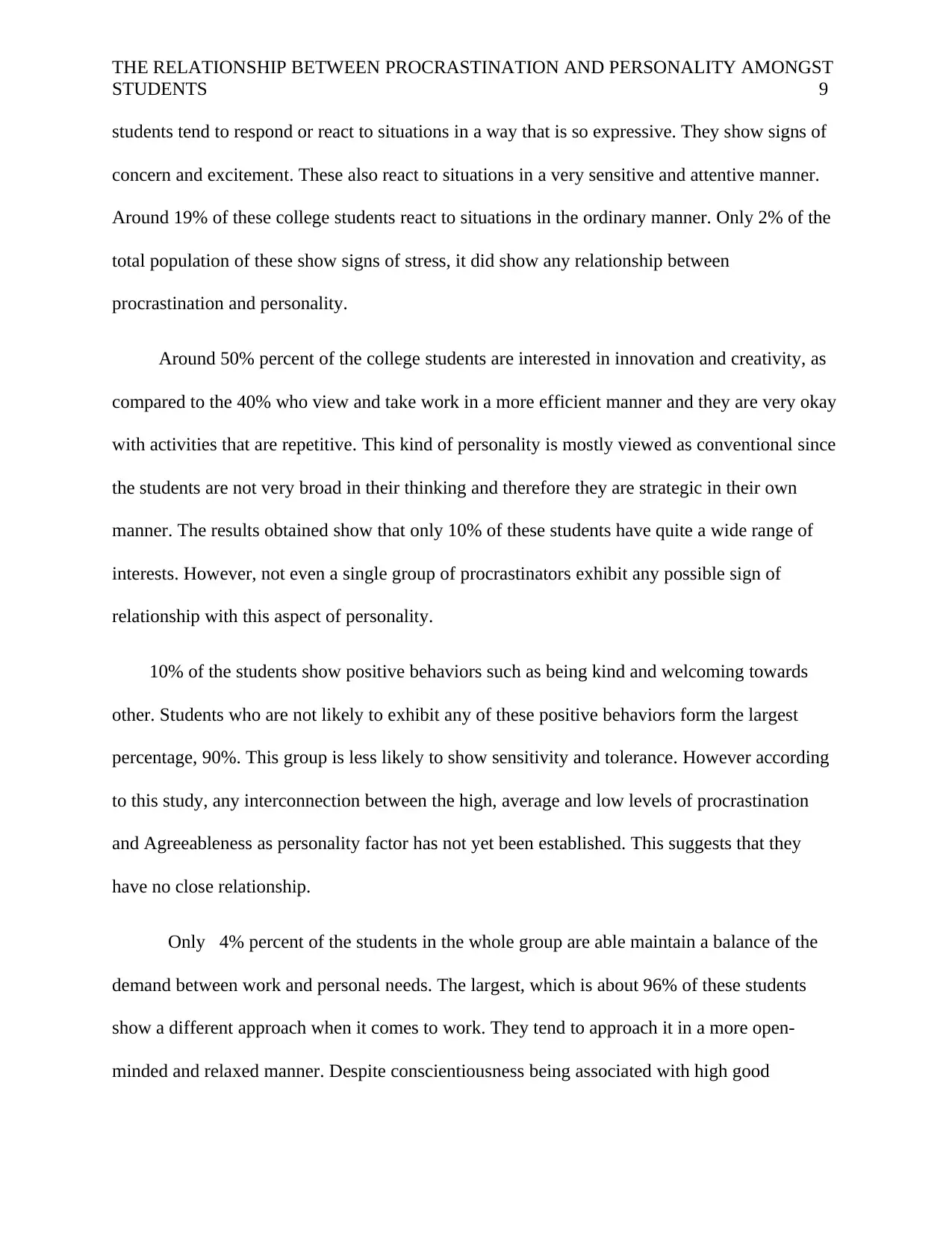
THE RELATIONSHIP BETWEEN PROCRASTINATION AND PERSONALITY AMONGST
STUDENTS 9
students tend to respond or react to situations in a way that is so expressive. They show signs of
concern and excitement. These also react to situations in a very sensitive and attentive manner.
Around 19% of these college students react to situations in the ordinary manner. Only 2% of the
total population of these show signs of stress, it did show any relationship between
procrastination and personality.
Around 50% percent of the college students are interested in innovation and creativity, as
compared to the 40% who view and take work in a more efficient manner and they are very okay
with activities that are repetitive. This kind of personality is mostly viewed as conventional since
the students are not very broad in their thinking and therefore they are strategic in their own
manner. The results obtained show that only 10% of these students have quite a wide range of
interests. However, not even a single group of procrastinators exhibit any possible sign of
relationship with this aspect of personality.
10% of the students show positive behaviors such as being kind and welcoming towards
other. Students who are not likely to exhibit any of these positive behaviors form the largest
percentage, 90%. This group is less likely to show sensitivity and tolerance. However according
to this study, any interconnection between the high, average and low levels of procrastination
and Agreeableness as personality factor has not yet been established. This suggests that they
have no close relationship.
Only 4% percent of the students in the whole group are able maintain a balance of the
demand between work and personal needs. The largest, which is about 96% of these students
show a different approach when it comes to work. They tend to approach it in a more open-
minded and relaxed manner. Despite conscientiousness being associated with high good
STUDENTS 9
students tend to respond or react to situations in a way that is so expressive. They show signs of
concern and excitement. These also react to situations in a very sensitive and attentive manner.
Around 19% of these college students react to situations in the ordinary manner. Only 2% of the
total population of these show signs of stress, it did show any relationship between
procrastination and personality.
Around 50% percent of the college students are interested in innovation and creativity, as
compared to the 40% who view and take work in a more efficient manner and they are very okay
with activities that are repetitive. This kind of personality is mostly viewed as conventional since
the students are not very broad in their thinking and therefore they are strategic in their own
manner. The results obtained show that only 10% of these students have quite a wide range of
interests. However, not even a single group of procrastinators exhibit any possible sign of
relationship with this aspect of personality.
10% of the students show positive behaviors such as being kind and welcoming towards
other. Students who are not likely to exhibit any of these positive behaviors form the largest
percentage, 90%. This group is less likely to show sensitivity and tolerance. However according
to this study, any interconnection between the high, average and low levels of procrastination
and Agreeableness as personality factor has not yet been established. This suggests that they
have no close relationship.
Only 4% percent of the students in the whole group are able maintain a balance of the
demand between work and personal needs. The largest, which is about 96% of these students
show a different approach when it comes to work. They tend to approach it in a more open-
minded and relaxed manner. Despite conscientiousness being associated with high good
⊘ This is a preview!⊘
Do you want full access?
Subscribe today to unlock all pages.

Trusted by 1+ million students worldwide
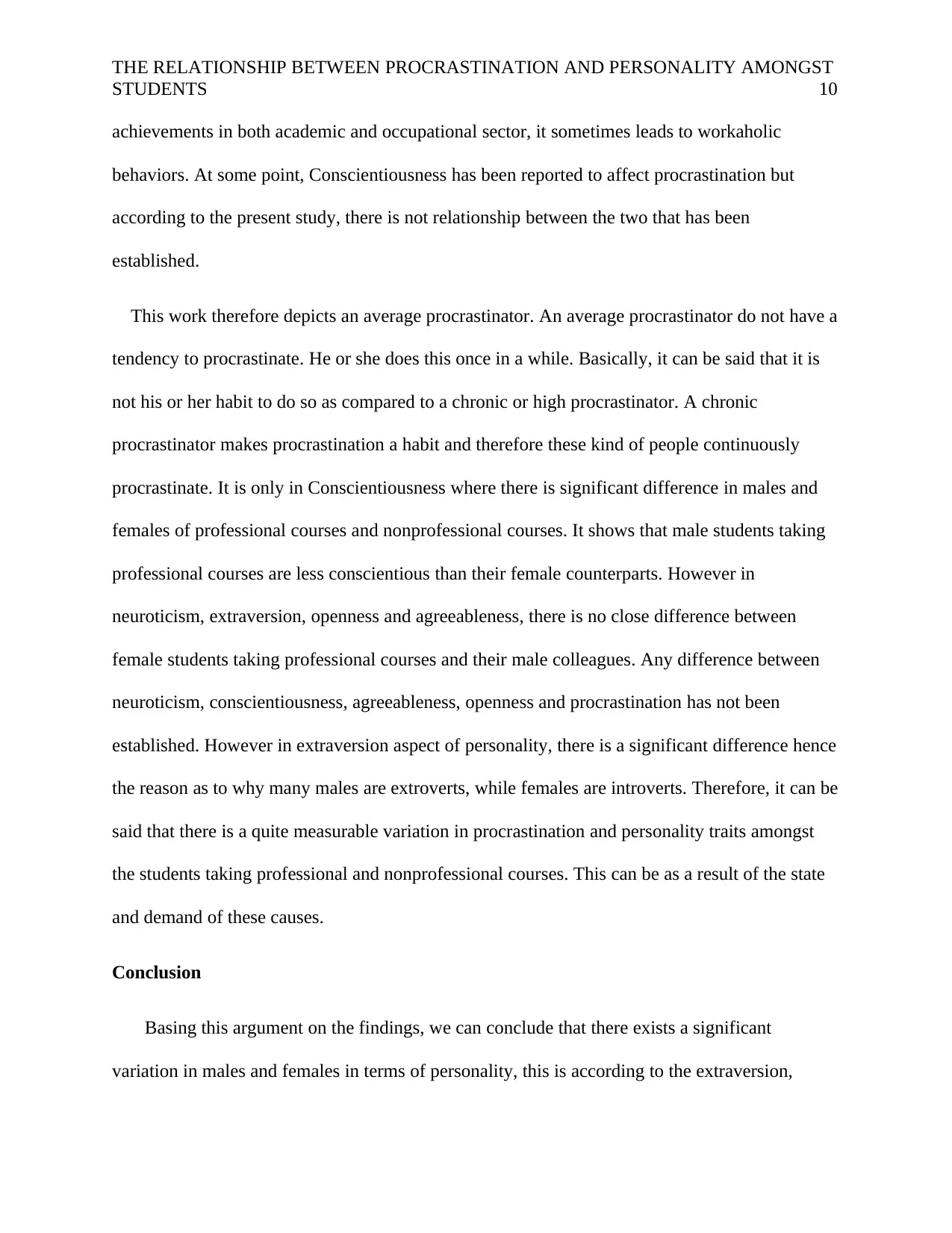
THE RELATIONSHIP BETWEEN PROCRASTINATION AND PERSONALITY AMONGST
STUDENTS 10
achievements in both academic and occupational sector, it sometimes leads to workaholic
behaviors. At some point, Conscientiousness has been reported to affect procrastination but
according to the present study, there is not relationship between the two that has been
established.
This work therefore depicts an average procrastinator. An average procrastinator do not have a
tendency to procrastinate. He or she does this once in a while. Basically, it can be said that it is
not his or her habit to do so as compared to a chronic or high procrastinator. A chronic
procrastinator makes procrastination a habit and therefore these kind of people continuously
procrastinate. It is only in Conscientiousness where there is significant difference in males and
females of professional courses and nonprofessional courses. It shows that male students taking
professional courses are less conscientious than their female counterparts. However in
neuroticism, extraversion, openness and agreeableness, there is no close difference between
female students taking professional courses and their male colleagues. Any difference between
neuroticism, conscientiousness, agreeableness, openness and procrastination has not been
established. However in extraversion aspect of personality, there is a significant difference hence
the reason as to why many males are extroverts, while females are introverts. Therefore, it can be
said that there is a quite measurable variation in procrastination and personality traits amongst
the students taking professional and nonprofessional courses. This can be as a result of the state
and demand of these causes.
Conclusion
Basing this argument on the findings, we can conclude that there exists a significant
variation in males and females in terms of personality, this is according to the extraversion,
STUDENTS 10
achievements in both academic and occupational sector, it sometimes leads to workaholic
behaviors. At some point, Conscientiousness has been reported to affect procrastination but
according to the present study, there is not relationship between the two that has been
established.
This work therefore depicts an average procrastinator. An average procrastinator do not have a
tendency to procrastinate. He or she does this once in a while. Basically, it can be said that it is
not his or her habit to do so as compared to a chronic or high procrastinator. A chronic
procrastinator makes procrastination a habit and therefore these kind of people continuously
procrastinate. It is only in Conscientiousness where there is significant difference in males and
females of professional courses and nonprofessional courses. It shows that male students taking
professional courses are less conscientious than their female counterparts. However in
neuroticism, extraversion, openness and agreeableness, there is no close difference between
female students taking professional courses and their male colleagues. Any difference between
neuroticism, conscientiousness, agreeableness, openness and procrastination has not been
established. However in extraversion aspect of personality, there is a significant difference hence
the reason as to why many males are extroverts, while females are introverts. Therefore, it can be
said that there is a quite measurable variation in procrastination and personality traits amongst
the students taking professional and nonprofessional courses. This can be as a result of the state
and demand of these causes.
Conclusion
Basing this argument on the findings, we can conclude that there exists a significant
variation in males and females in terms of personality, this is according to the extraversion,
Paraphrase This Document
Need a fresh take? Get an instant paraphrase of this document with our AI Paraphraser
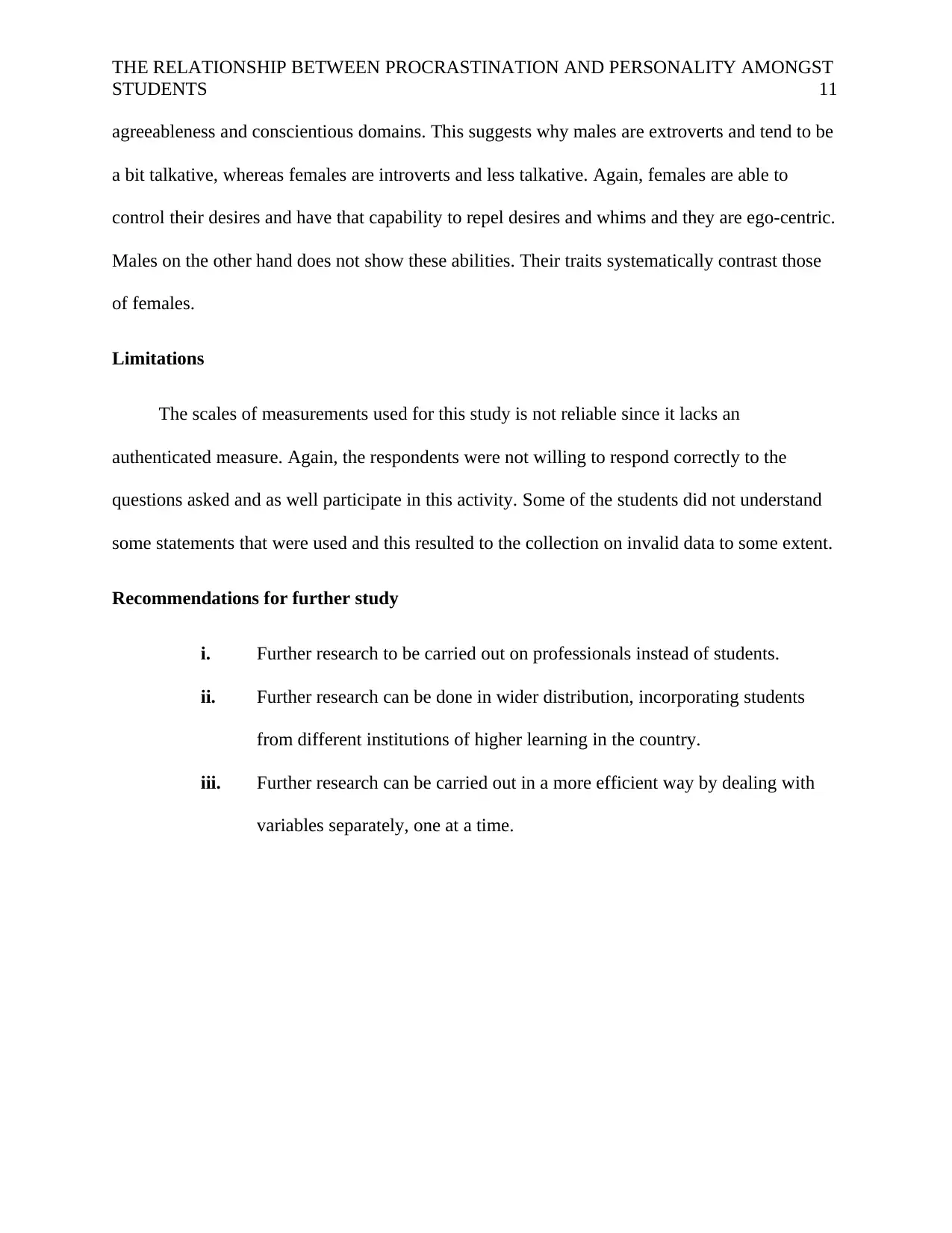
THE RELATIONSHIP BETWEEN PROCRASTINATION AND PERSONALITY AMONGST
STUDENTS 11
agreeableness and conscientious domains. This suggests why males are extroverts and tend to be
a bit talkative, whereas females are introverts and less talkative. Again, females are able to
control their desires and have that capability to repel desires and whims and they are ego-centric.
Males on the other hand does not show these abilities. Their traits systematically contrast those
of females.
Limitations
The scales of measurements used for this study is not reliable since it lacks an
authenticated measure. Again, the respondents were not willing to respond correctly to the
questions asked and as well participate in this activity. Some of the students did not understand
some statements that were used and this resulted to the collection on invalid data to some extent.
Recommendations for further study
i. Further research to be carried out on professionals instead of students.
ii. Further research can be done in wider distribution, incorporating students
from different institutions of higher learning in the country.
iii. Further research can be carried out in a more efficient way by dealing with
variables separately, one at a time.
STUDENTS 11
agreeableness and conscientious domains. This suggests why males are extroverts and tend to be
a bit talkative, whereas females are introverts and less talkative. Again, females are able to
control their desires and have that capability to repel desires and whims and they are ego-centric.
Males on the other hand does not show these abilities. Their traits systematically contrast those
of females.
Limitations
The scales of measurements used for this study is not reliable since it lacks an
authenticated measure. Again, the respondents were not willing to respond correctly to the
questions asked and as well participate in this activity. Some of the students did not understand
some statements that were used and this resulted to the collection on invalid data to some extent.
Recommendations for further study
i. Further research to be carried out on professionals instead of students.
ii. Further research can be done in wider distribution, incorporating students
from different institutions of higher learning in the country.
iii. Further research can be carried out in a more efficient way by dealing with
variables separately, one at a time.
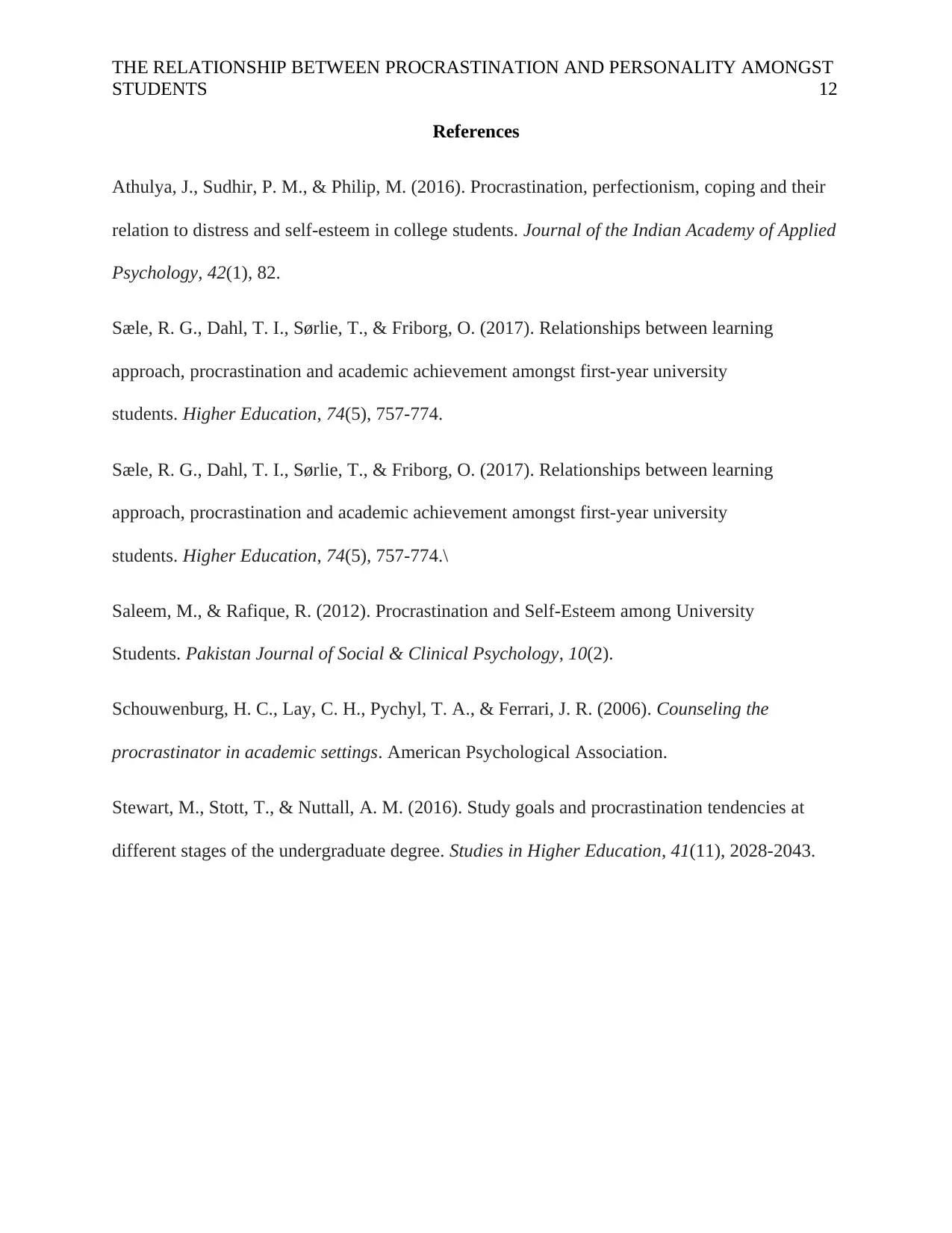
THE RELATIONSHIP BETWEEN PROCRASTINATION AND PERSONALITY AMONGST
STUDENTS 12
References
Athulya, J., Sudhir, P. M., & Philip, M. (2016). Procrastination, perfectionism, coping and their
relation to distress and self-esteem in college students. Journal of the Indian Academy of Applied
Psychology, 42(1), 82.
Sæle, R. G., Dahl, T. I., Sørlie, T., & Friborg, O. (2017). Relationships between learning
approach, procrastination and academic achievement amongst first-year university
students. Higher Education, 74(5), 757-774.
Sæle, R. G., Dahl, T. I., Sørlie, T., & Friborg, O. (2017). Relationships between learning
approach, procrastination and academic achievement amongst first-year university
students. Higher Education, 74(5), 757-774.\
Saleem, M., & Rafique, R. (2012). Procrastination and Self-Esteem among University
Students. Pakistan Journal of Social & Clinical Psychology, 10(2).
Schouwenburg, H. C., Lay, C. H., Pychyl, T. A., & Ferrari, J. R. (2006). Counseling the
procrastinator in academic settings. American Psychological Association.
Stewart, M., Stott, T., & Nuttall, A. M. (2016). Study goals and procrastination tendencies at
different stages of the undergraduate degree. Studies in Higher Education, 41(11), 2028-2043.
STUDENTS 12
References
Athulya, J., Sudhir, P. M., & Philip, M. (2016). Procrastination, perfectionism, coping and their
relation to distress and self-esteem in college students. Journal of the Indian Academy of Applied
Psychology, 42(1), 82.
Sæle, R. G., Dahl, T. I., Sørlie, T., & Friborg, O. (2017). Relationships between learning
approach, procrastination and academic achievement amongst first-year university
students. Higher Education, 74(5), 757-774.
Sæle, R. G., Dahl, T. I., Sørlie, T., & Friborg, O. (2017). Relationships between learning
approach, procrastination and academic achievement amongst first-year university
students. Higher Education, 74(5), 757-774.\
Saleem, M., & Rafique, R. (2012). Procrastination and Self-Esteem among University
Students. Pakistan Journal of Social & Clinical Psychology, 10(2).
Schouwenburg, H. C., Lay, C. H., Pychyl, T. A., & Ferrari, J. R. (2006). Counseling the
procrastinator in academic settings. American Psychological Association.
Stewart, M., Stott, T., & Nuttall, A. M. (2016). Study goals and procrastination tendencies at
different stages of the undergraduate degree. Studies in Higher Education, 41(11), 2028-2043.
⊘ This is a preview!⊘
Do you want full access?
Subscribe today to unlock all pages.

Trusted by 1+ million students worldwide
1 out of 18
Related Documents
Your All-in-One AI-Powered Toolkit for Academic Success.
+13062052269
info@desklib.com
Available 24*7 on WhatsApp / Email
![[object Object]](/_next/static/media/star-bottom.7253800d.svg)
Unlock your academic potential
Copyright © 2020–2025 A2Z Services. All Rights Reserved. Developed and managed by ZUCOL.





